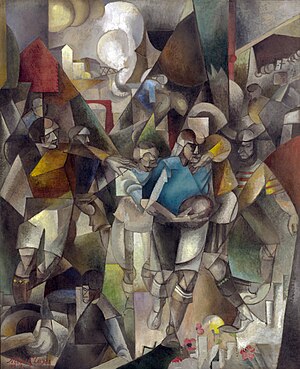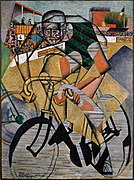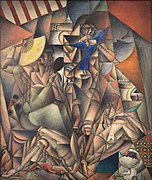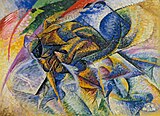|
Football Players
Football Players (French: Les Joueurs de football) is a 1912–13 painting by the French artist Albert Gleizes. The work was exhibited at the Salon des Indépendants, Paris, March–May 1913 (no. 1293). September through December 1913 the painting was exhibited at Erster Deutscher Herbstsalon, Berlin (no. 147). The work was featured at Galeries Dalmau in Barcelona, 29 November – 12 December 1916 (no. 31), Gleizes' first one-person show.[1] The work was again exhibited at Galeries Dalmau 16 October – 6 November 1926 (no. 7).[2] Stylistically Gleizes' Football Players exemplifies the principle of mobile perspective laid out in Du "Cubisme", written by himself and French painter Jean Metzinger. Guillaume Apollinaire wrote about Les Joueurs de football in an article titled "Le Salon des indépendants", published in L'Intransigeant, 18 March 1913, and again in "A travers le Salon des indépendants", published in Montjoie!, Numéro Spécial, 18 March 1913.[3] Les Joueurs de football was left by the artist at Galeries Dalmau in 1916. Titled Jugadors de Futbol, the painting was reproduced in the avant-garde Catalan magazine L'Amic de les arts, November 1926. The caption included the inscription Collection Joseph Dalmau.[4] It was purchased from the Dalmau family between 1953 and 1955 by Stephen Hahn and (The Sidney Janis Gallery); sold in 1955 to Nelson Aldrich Rockefeller, New York. Subsequently the work was sold to the Marlborough-Gerson gallery, New York, and purchased May 1970 by the National Gallery of Art (NGA), Washington D.C.[5] Description   Les Joueurs de football is a large oil painting on canvas with dimensions 225.4 x 183 cm (88 3/4 x 72 1/16 in.) signed and dated "Albert Gleizes 1912–13", lower left. After at least one preliminary sketch,[6] Gleizes began working on this painting in 1912 and finished it before exhibiting the work at the Salon des Indépendants, March 1913.[7] Moving away from his quasi-monochromatic works of 1910 and 1911, Gleizes employs a wide array of primary colors, grays, earth tones and umbers. Unlike the preferred subject matter of Pablo Picasso and Georges Braque (e.g., still lives or guitar players), Gleizes has depicted a vast scene, combining a sporting event with a semi-urban or industrial landscape in the background. As the principle subject matter of this work Gleizes chose to represent a group of six or seven rugby football players. The action and contact between the players is palpable. Two of the men are holding on to the player with the ball (blue jersey) as if a tackle is imminent. In contrast to the impending violence of the sport, Gleizes has painted flowers along with some cubic shapes toward the bottom right of the picture. On the bottom left is a man, possibly a fallen player, holding what appears to be a round shaped item in his hand. Spectators are seen toward the upper right, while to the left, in the background, Gleizes has painted a town, a bridge and bellowing clouds or smoke. The rich juxtaposition of divers elements present within the piece are tied together in a Cubist idiom by an interlocking grid of diagonal lines, facets, intersecting plains and spheres. OverviewPainted during an ongoing debate over the virtues of Cubism and Futurism, Les Joueurs de football is a prime example of the artists desire to reconcile the problem of representing the subject from different points of view simultaneously, and/or in successive stages of motion (both the physical displacement of an object and the movement of thought).[8] Here, according to art historian Peter Brooke, Gleizes explores the movement of subjects in motion "with the sense of movement that can be excited in the spectator using purely pictorial means". Brooke continues, "The drama can be seen very clearly expressed in Gleizes's painting Les Joueurs de football, in which a very powerful pictorial construction is undermined by the idea of aggressive movement, very rare for Gleizes, conveyed in the frozen gestures of the subject, the football players".[8] Guillaume Apollinaire writes in Montjoie! on 18 March 1913:[3]
Les Joueurs de football is testament to the close association of two artists, Metzinger and Gleizes, and to their shared social, cultural and philosophical conviction that painting represented more than a fleeting glimpse of the world in which they lived, that indeed by showing multiple facets of a subject captured at successive intervals in time simultaneously, a truer more complete image would emerge.[9]
Gleizes' Football Players exemplifies the principle of mobile perspective and simultaneity elaborated upon in the Cubist manifesto Du "Cubisme", written with Jean Metzinger. Football Players exemplifies, too, the general freedom of the artist to interpret the subject matter without producing photograph resemblance or ‘realistic’ portrayal of an object or event. For Metzinger and Gleizes, such a portrayal was simply an arbitrary convention. In the world of experience, things are not static, but in constant motion. Objects are rarely seen from one point of view, and the act of perception is systematically accompanied by a collection of emotions and thoughts. Life is not a 'purely retinal' experience.[8] Rugby football The apparition of The Football Players (1908) in the work of Henri Rousseau signaled the emergence of sporting events as a subject for art.[12] Jean Metzinger painted At the Cycle-Race Track (Au Vélodrome) (1911–12) Peggy Guggenheim Collection; Umberto Boccioni, Dynamism of a Cyclist (1913), Peggy Guggenheim Collection and Dynamism of a Soccer Player (1913) Museum of Modern Art. Robert Delaunay worked on a series of rugby football scenes from 1912 to 1913, and again in 1924.[13] André Lhote, later, painted the subject several times, between 1917 and 1937.[12][14] In both the Gleizes painting and those of Delaunay, the identification with soccer has commonly been made, however, the ball is oval and the hands are being used; clearly identifying the subject of these works as depictions of rugby football games.[15] The first rugby competition was held in 1892 as a one-off championship game between two Paris-based teams, the Racing Club de France and Stade Français. In 1900 rugby was played at the Paris Summer Olympics. France won the gold medal of the first ever rugby event at the Olympics. Racing Club made it to the championship final on 31 March 1912. France joined an international competition in 1910, and coined the term Tournoi des Cinq Nations (Five Nations Championship); a term that would last almost the entire century.[16] On 1 January 1913, at the France-Scotland match, spectators threw themselves on the referee to express their dissatisfaction. The mounted police were forced to intervene charging. This violent incident led to the secretary of the Scottish Rugby Union to declare: "If the game can only be played under the protection of the police or the military, it is not worth playing".[17] Following this incidents, Scotland refused to face France at the 1914 tournament.[18] France was implicitly excluded from further tournaments, but World War I did not permit the application of this exclusion. The related sport-themed work of Rousseau, Metzinger, Gleizes, Delaunay, Boccioni (and later Lhote), reflected the enthusiasm for sport that fascinated the French spirit at the time. Romain Rolland described the Belle Époque generation as "Passionately in love with pleasure and violent games", in his 1912/13 novel Jean-Christophe.[12] Art historian Daniel Robbins writes:
Related works
InscriptionsAlbert Gleizes 1912–13, lower left; center right reverse: 25 nov[e]mbre 191[?] ProvenanceLeft 1916 by the artist at the Gallery Dalmau, Barcelona; Dalmau family, Barcelona; purchased 1953/1955 by Stephen Hahn and (Janis Gallery, New York); sold 1955 to Nelson Aldrich Rockefeller, New York; sold to (Marlborough-Gerson Gallery, Inc., New York); purchased May 1970 by National Gallery of Art (NGA). The details of the provenance are provided in a letter of 10 February 1970 from Daniel Robbins to J. Carter Brown, copy in NGA curatorial files. See alsoExhibitions
Bibliography
References
External links |
||||||||||||||||








